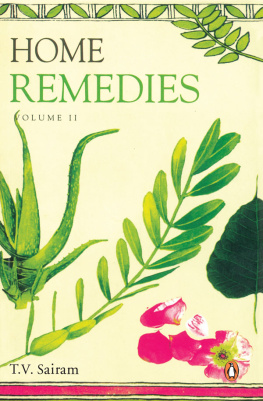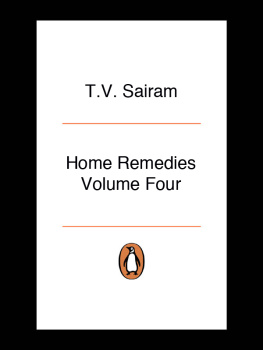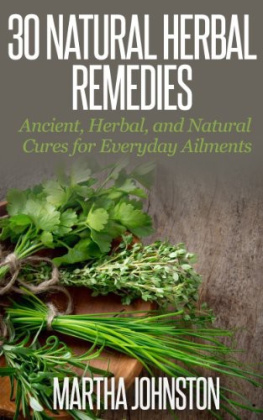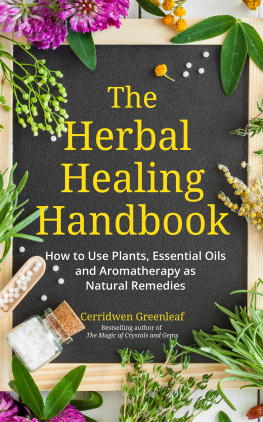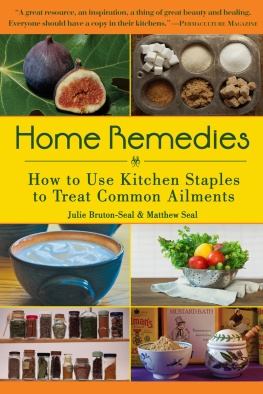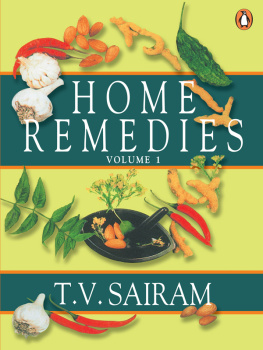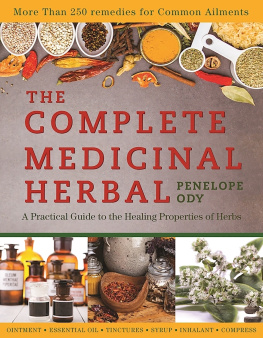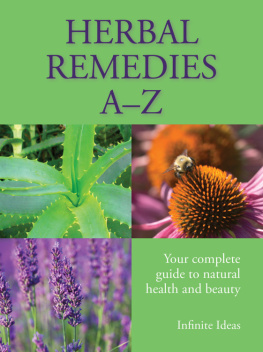Sairam - Home remedies a handbook of herbal cures for common ailments 2
Here you can read online Sairam - Home remedies a handbook of herbal cures for common ailments 2 full text of the book (entire story) in english for free. Download pdf and epub, get meaning, cover and reviews about this ebook. City: New Delhi u.a, year: 2013;1999, publisher: Penguin Books Ltd, genre: Home and family. Description of the work, (preface) as well as reviews are available. Best literature library LitArk.com created for fans of good reading and offers a wide selection of genres:
Romance novel
Science fiction
Adventure
Detective
Science
History
Home and family
Prose
Art
Politics
Computer
Non-fiction
Religion
Business
Children
Humor
Choose a favorite category and find really read worthwhile books. Enjoy immersion in the world of imagination, feel the emotions of the characters or learn something new for yourself, make an fascinating discovery.
- Book:Home remedies a handbook of herbal cures for common ailments 2
- Author:
- Publisher:Penguin Books Ltd
- Genre:
- Year:2013;1999
- City:New Delhi u.a
- Rating:4 / 5
- Favourites:Add to favourites
- Your mark:
- 80
- 1
- 2
- 3
- 4
- 5
Home remedies a handbook of herbal cures for common ailments 2: summary, description and annotation
We offer to read an annotation, description, summary or preface (depends on what the author of the book "Home remedies a handbook of herbal cures for common ailments 2" wrote himself). If you haven't found the necessary information about the book — write in the comments, we will try to find it.
Sairam: author's other books
Who wrote Home remedies a handbook of herbal cures for common ailments 2? Find out the surname, the name of the author of the book and a list of all author's works by series.
Home remedies a handbook of herbal cures for common ailments 2 — read online for free the complete book (whole text) full work
Below is the text of the book, divided by pages. System saving the place of the last page read, allows you to conveniently read the book "Home remedies a handbook of herbal cures for common ailments 2" online for free, without having to search again every time where you left off. Put a bookmark, and you can go to the page where you finished reading at any time.
Font size:
Interval:
Bookmark:


A Handbook of Herbal Cures for Common Ailments
Illustrations by Amitabh

PENGUIN BOOKS
PENGUIN BOOKS
VOLUME TWO
T. V. Sairam, a senior member of the civil services, holds a Masters degree in botany and a doctorate in alternative medicine. For the past three decades he has been gathering and documenting data relating to the household use of medicinal plants.
The book presents the material related to 40 common medicinal plants... in a very lucid manner... The most useful part of the book is that it provides notes on preparation of herbal medicine, dosage and some thumb rules for the selection of the various parts of the medicinal plant.... An interesting bibliography also accompanies the book... a complete guide on medicinal herbs. It caters to the need of both the common man and a practitioner alike.
Deccan Herald
... an excellent and beautifully produced book, rich in information... The chapters have been structured thoughtfully... The author has produced an eminently readable and useful book...
Indian Review of Books
The author meticulously documents many parallel traditions and their uses of individual plants to cure and comfort... an illuminating rediscovery of herbs...
First City
A glossary of English medical terms and the Indian names of the herbs in quite a few regional languages does prove helpful.
The Statesman
Years of research on ancient herblore by T.V. Sairam is slowly but surely taking the shape of easy-to-use volumes on the medicinal values of the phenomenal wealth the country has in herbs...
The Hindu
The Financial Express
A very useful book.
For the innumerable housewives, ojhas, hakims and vaidyars who continue to practise their arts in difficult times
Systematic research in various systems of Indian medicine under the patronage of the Government of India commenced in the year 1969 with the establishment of the Central Council for Research in Indian Medicine and Homoeopathy (CCRIMH). In 1978, this body was split into four separate research councils: one each for Ayurveda and Siddha, Unani medicine, Homoeopathy, and Yoga and Naturopathy.
A recent WHO estimate reveals that around 80 per cent of the global population consume phyto-medicines, and documents a shift in emphasis from the underdeveloped to the developed countries of the world. This trend has both positive and negative fallouts in society. While the prices of useful herbs skyrocket in the developing world as their main sources are depleted, the rural poor who have long been dependent on them find them unaffordable when compared to synthetic drugs and medicines. Even in the remote corners of rural and tribal India, we notice that branded synthetic medicines manufactured by multinational concerns have begun to percolate.
A survey conducted by researchers at the Beth Israel Deaconess Medical Centre and the Harvard Medical School in Boston reveals that the use of herbal medicines and other alternative therapies has shown a steep rise in the United States, with sales of herbal remedies increasing by 380 per cent during the nineties. The number of visits made by American patients to herbalists, chiropractors and other purveyors of alternative medicine is reported to exceed the total visits to all primary-care physicians.
The trend indicates the changing attitudes in modern society in general with regard to complementary and alternative systems of medicine.
A comparative study of ethno-botanical information contained in ancient Indian literature with folk medical lore, research amongst tribal communities and current scientific findings can go a long way in establishing the direction of future medical exploration.
The recent publication of the Indian Herbal Pharmacopoeia is a giant leap in this direction; some herbs have been standardized and twenty herbs have had monographs devoted to them. No doubt much work remains to be done. In order to obtain consistent results, the standardization of the product has to be monitored right from the raw-material stage. The habitat of the plant and the time of collection play a vital role in achieving consistency.
Although there have been attempts at a broader understanding of drugs based on their chemistry and pharmacology, India can perhaps follow China, where experimental results are immediately passed on to clinical investigators, who provide the necessary support in the clinical evaluation of particular drugs.
The Indian subcontinent contains about 25,000 species of vascular plants, of which 7500 are used by folk and other traditional systems of medicine. Many plants are common to all the traditional systems. Several are used either alone or in combination with other plants. The current regulations state that if these drugs are prepared in exactly the same way as laid down in ancient literature and if they are preserved as detailed by the texts, such drugs do not require either approval of registration. The drug will however be treated as new whenever a different method of preparation is used.
The subcontinent occupies a unique position in the world, capable of cultivating most of the medicinal plants used both in modern as well as traditional systems of medicine.
While India has to travel a long way to become self-sufficient in pharmaceutical production, the largest chunk of medicinesalmost 70 per centdraw on the indigenous systems of medicine catering to the needs of most of our rural people.
The export value of crude drugs from India in the international market has increased 2.76 times between 198586 and 199495, and now stands at 53.2 million.
Although India is one of the major suppliers of medicinal plants to the world, the export of value-added materials such as plant derivatives, chemicals, etc. is insignificant compared to the developed countries.
According to an UNIDO study, although there were 3349 units licensed to manufacture plant-based pharmaceuticals in 1987, their contribution to the total production was considered marginal.
A systematic survey of all medicinal flora is the need of the hour. While that may safely be left to dedicated researchers, this book is my attempt to contribute by documenting and making available to a larger public what I have seen practised in the course of my researches.
This second volume of Home Remedies follows on from where the first had left off, hoping to reclaim a place on our kitchen shelves and in our lives for plants we have come to dismiss lightly.
For cutting off the tender sprouts, a fine of six panas will be imposed; for cutting off the minor branches, twelve panas and for cutting off the big branches, twenty-four panas. Cutting off the trunk will be punished with the first amercement; and felling will be punished with the middlemost amercement.
Arthashastra, III 19:197
The writing of this book was undertaken to fill what I perceive to be a serious void between the ethnic discovery of herbs and their scientific rediscovery.
It was felt that collecting and categorizing available data from folklore as well as the Western scientific literature on medicinal herbs would facilitate an informed understanding that could better evaluate the premises and methodology of the complicated and often misunderstood role of herbalism and alternative medicine. Herbs are often seen as the last resort once all other avenues of treatment have been exhausted. Being approached as last-minute miracle workers serves to reinforce the mystic aura associated with such systems of medicine, thus discounting the sophisticated and ancient herb lore that its practitioners draw on. The hereditary household remedial system handed down by often unlettered women, the village vaids, hakims and ojhas and their travelling counterparts represent the fragmentary remnants of systems evolved to perfection to meet the needs of localized communities, drawing on familiar plants and locally available materials to treat ailments. Such practices are however fast becoming extinct, and I have often noted on my travels that even in a far-flung village, it has become the fashion to go for a tablet of aspirin rather than a piece of ginger, unmindful of the feeble voice of a family elder or the village physician.
Font size:
Interval:
Bookmark:
Similar books «Home remedies a handbook of herbal cures for common ailments 2»
Look at similar books to Home remedies a handbook of herbal cures for common ailments 2. We have selected literature similar in name and meaning in the hope of providing readers with more options to find new, interesting, not yet read works.
Discussion, reviews of the book Home remedies a handbook of herbal cures for common ailments 2 and just readers' own opinions. Leave your comments, write what you think about the work, its meaning or the main characters. Specify what exactly you liked and what you didn't like, and why you think so.

